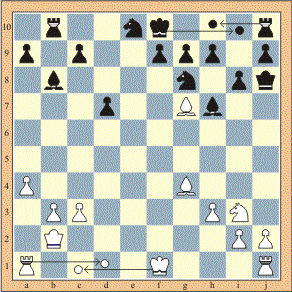The properties of the Pawns, their position in the game and their positive and negative side are well known. Since the foundation of European chess 500 years ago chess was played without the understanding of the position principles. The Pawns were only attackers and cheap casualties. Although today we understand the Pawns differently, the impression that the Pawn is a weak figure remains. Chess'3 increases the movement features of the Pawns by one-field straight bacward movement, until certain limit is reached. Another new feature is that when changing the Pawn for another piece the Pawns can be changed for a piece which is out of the game.
The Pawn can move one field forward, except from the beginning position, when it can move one, two or three fields forward. Chess'3 increases movements of Pawns with movements one field backwards. This movement can only take place for the white Pawn when it's original position lies between the 10th and the 5th rank. For the black Pawn, this movement can only take place when it's original position lies between the 1st and the 6th rank.
When making a capture a Pawn moves one field diagonally. When moving back the Pawn can't make a capture by moving diagonally backwards, but it can attack by the rules of moving forward.
On reaching the last rank the Pawns can be exchanged for another piece (a Queen, a Rook, a Bishop, a Civilian or a Knight), but it can only be replaced by the piece, which was previously captured by the opponent.Promotion also takes place if on its final move the promoted pawn made a capture. Exchange for the King is not allowed.
The promotion is not oblikatory, the Pawn can keep his funktion as a Pawn and stay in the game.
The Civilian can be moved from its position to any field vertically, horizontally or diagonally, just like the Queen. It can also be moved in the shape of the letter "L" (straight or mirrored), just like the knight. That way it can reach one of 43 available fields which makes it the most movable piece in the set.
The Civilian doesn't have the right to make a capture directly (peaceful figure)! But when the opponent starts the process of capturing, the Civilian becomes equal to other pieces (it has the right to capture opponents pieces), bat only for the period of the action (sequence capturing). After that period his right of capturing ceases.
*Opponents pieces can attack the Civilian for capturing or blocking and Civilian can react by redraw or by sacrifice.
*The Civilian does not posses the right to check or checkmate the opponents King. If the player's King is in check, he can only react with the Civilian by blocking and not by making a capture, except in the case, when his King is in sheckmate position (if there's no other option). In that case the player's Civilian can react by making a capture.
*The Civilian can obstruct opponents pieces in attack or defence with sequence capturing, blocking or sacrifice.
*The Civilian can directly protect movements of friendly pieces all over the chessboard, so it increases tactical possibilietes of the attack.
*The Civilian can take active part in the attack, capturing (sequence) of the opponent's pieces or checkmating.
Next: page 5
Written by Redzo Kolakovic.
WWW page created: August 7, 2005.
The Castling is a combined move of the King and the Rook. It can only be done if none of those pieces hasn't been moved yet. When Castling, we move the King three fields toward the Rook and then we move the Rook over the King on the near position. Castling can't be done if the King is in chess, or if the opponents piece attacks the field that the King crosses. We also can't make a Castling, if the King steps on the attacked field or if there's another piece between the King and the Rook.
In the position on the diagram the player with white pieces has an option to castle by moving the King three fields left (from f1 to c1) and by moving the Rook three fields to the right (from a1 to d1). The player can't castle by moving the King to the right, because the black Bishop on b8 attacks the field i1.
In the same position the player with the black pieces has an option to castle by moving the King three fields to the right (from f10 to i10) and by moving the Rook two fields to the left (from j10 to h10). The player can't castle by moving the King to the left; he moved the Rook from a10 to b10; there is the Knight on e10 between the King and the Rook; the white Bishop from g7 attacks field d10.


